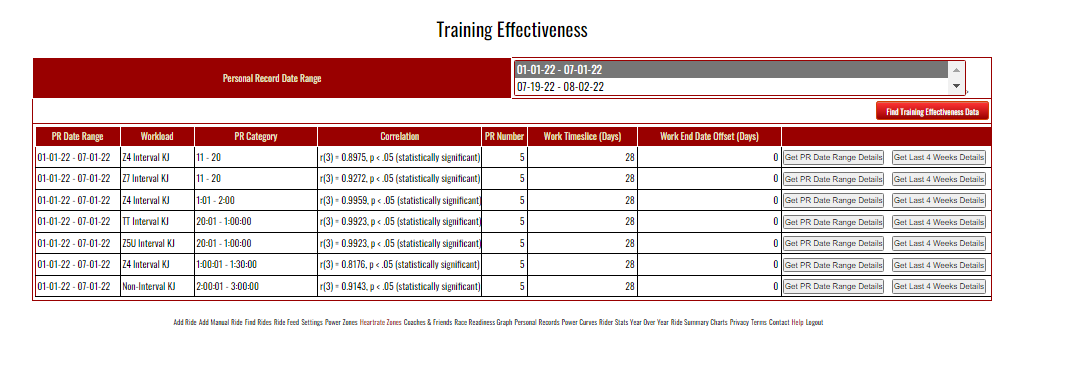|
Home > Reports > Training Effectiveness
Training Effectiveness
A Training Effectiveness analysis run analyzes your workload (both interval & non-interval) and Personal Records data for a substantial time period and extracts those where a statistically significant correlation between workload and performance was found.
Users will get an Insight Notification summarizing the number of correlations found when an analysis run is completed. Analysis runs will occur every 6 months. The notification will contain a link to the new Training Effectiveness Report where users can select a date range and return
all of the statistically significant correlations between various aspects of their workload and their Personal Records. Here's a sample screen:
Here's a correlation from my data:
01-01-22 - 07-01-22 TT Interval KJ 20:01 - 1:00:00 r(3) = 0.9923, p < .05 (statistically significant)  Here's a correlation from my data:
01-01-22 - 07-01-22 TT Interval KJ 20:01 - 1:00:00 r(3) = 0.9923, p < .05 (statistically significant)
It says that there was a statistically significant correlation between TT interval work (TT = aro FTP) and my PR's in the 20 minute to 1 hour timebox. Since I do a fair amount of training in that range I'm going to make the call that the training in that range had a causal effect on the PR.
Since this training was effective for me I might want to include more of it in my current training mix. The Training Effectiveness report has buttons for each Correlation which run sub-reports which allow you to evaluate further details for both your PR and Workload for the reporting period vs the PR and Workload for your last 4 weeks of training. If I have a race coming up where I can use enhanced performance from 20:01 - 1:00:00, and my current PR for that timebox is less than the reporting period, and my current workload in the TT interval range is less than the workload accomplished during the reporting period, then stepping up TT interval work would likely be a good use of training time.
Training in interval ranges that have been proven to be effective for a cyclist in the past can help the cyclist optimize their potential!
See also
| 




